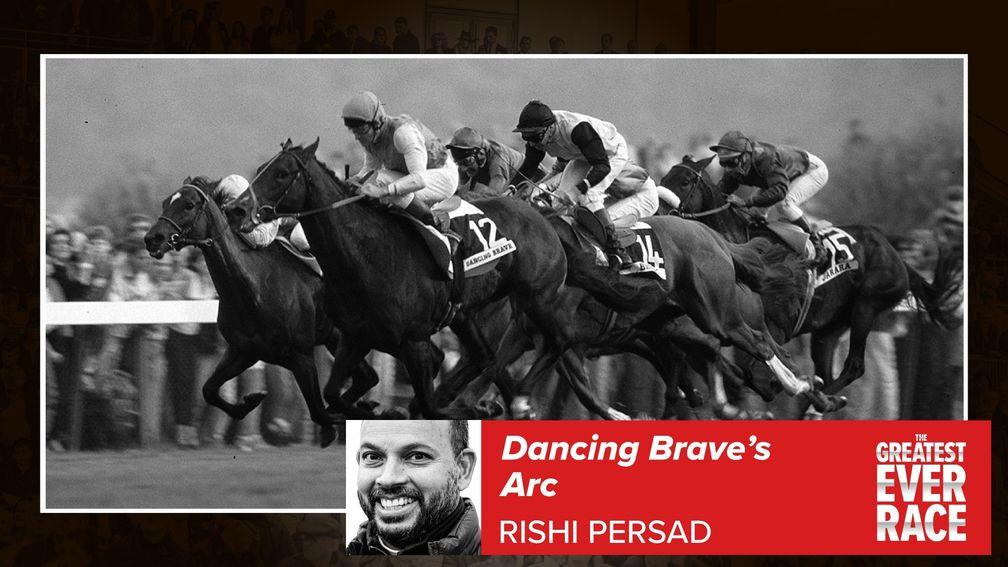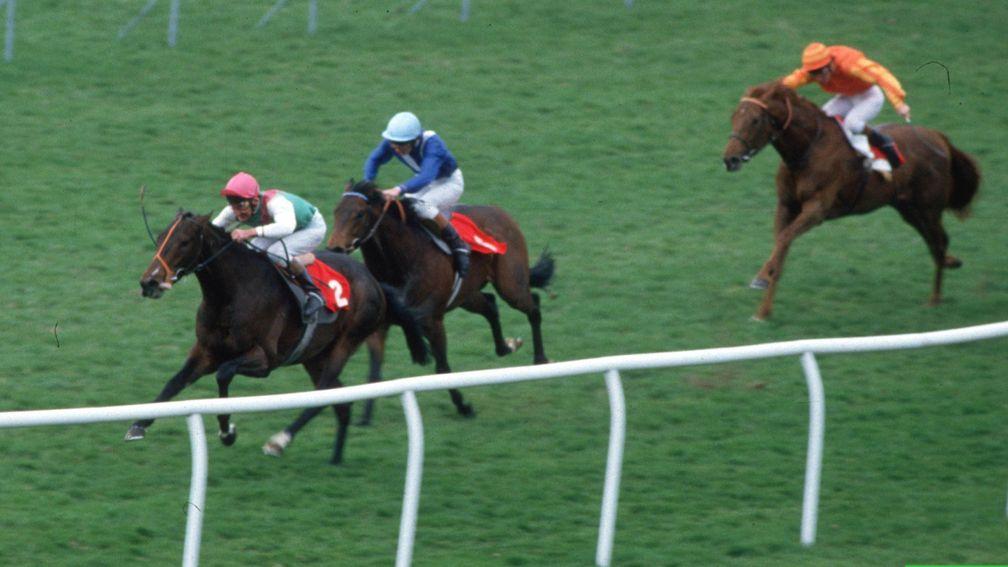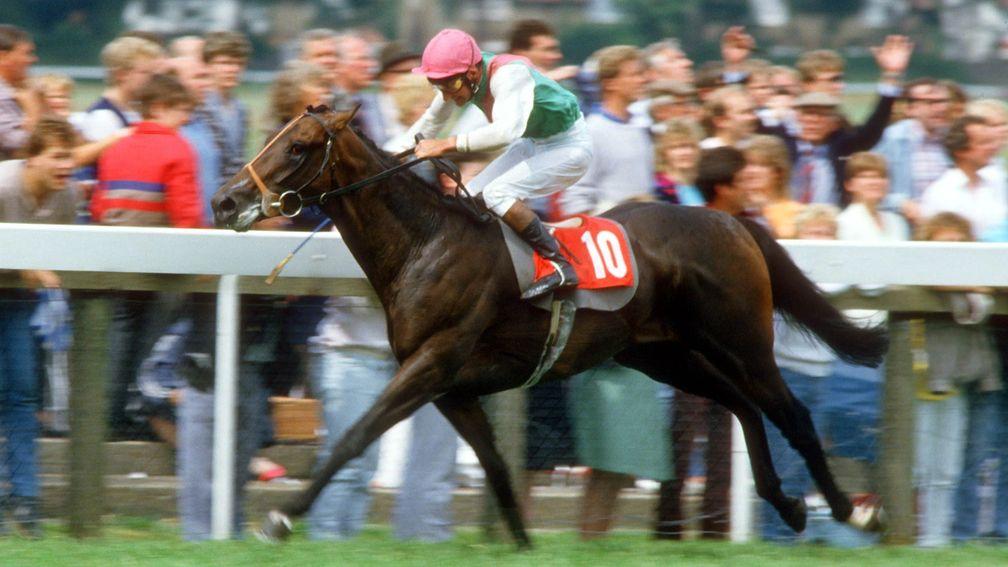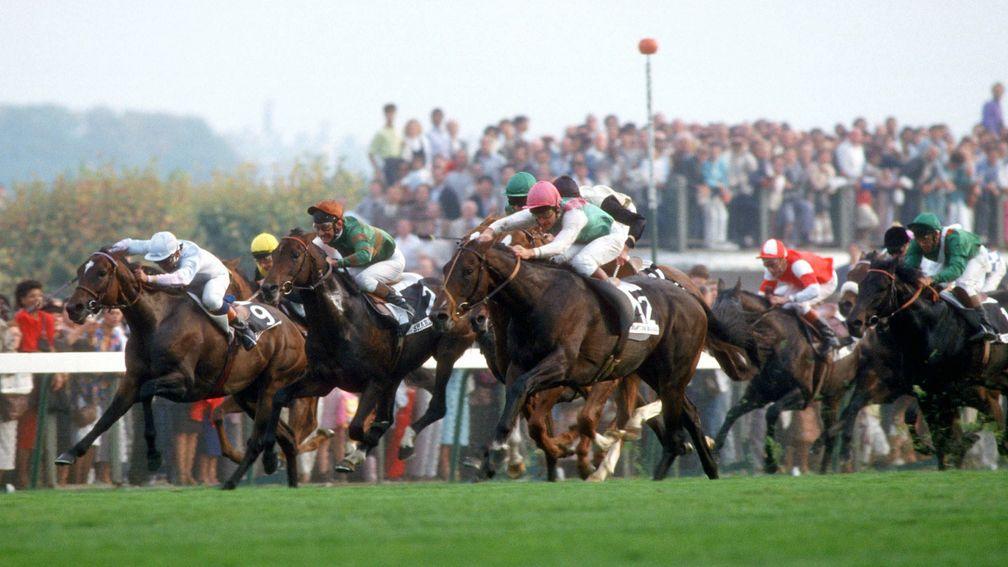We believed Dancing Brave could fly - and then he took off to prove it

Voting has now closed for The Greatest Ever Race but you can still read our ten fantastic articles. Below, broadcaster Rishi Persad nominates Dancing Brave's Prix de l'Arc de Triomphe success in 1986. The winner will be announced at racingpost.com at 6pm on Saturday, July 23.
What constitutes a great horserace? The answer, of course, is subjective.
This series has identified a number of different examples, highlighting the many contrasting scenarios and conditions that have served to deliver those memorable moments in the history of the sport. But the one element that we all share when we see a race for the ages is how it made us feel: the nervous pre-race excitement that morphs into an adrenaline surge and a wave of emotion that, briefly, removes our thoughts from the conscious, taking us to a place of bliss.
And whether you experienced those moments with shouts of "go on, my son" or silent appreciation, you intuitively know you have shared something special with the entire racing community. Irrespective of whether you are at the course or watching on television, for a fleeting moment we are in sync, all feeling something similar.
My first and still the sweetest taste of this racing nirvana came in the autumn of 1986 when I witnessed the single most stunning performance I have ever seen on a racecourse.
In the summer of 1984 a parrot-mouthed bay colt by Lyphard had passed through a Kentucky sales ring and despite being noted as "not particularly attractive" by observers, he turned enough heads to force agent James Delahooke to part with $200,000 on behalf of Khalid Abdullah.
However, upon his arrival in England he was rejected by Jeremy Tree, who had first choice of Abdullah's yearlings but had not been particularly enamoured with previous progeny by Lyphard that had fallen under his care. Instead the colt was sent to be trained by Guy Harwood in Pulborough.
And so began the story of Dancing Brave.
"He was a late May foal and when he came to me he went down to the bottom yard with the backward yearlings," said Harwood.
"One day in July I was watching the third lot from the bottom yard and said to my lad Chris Read, 'What's that horse, Chris?' He said, 'That's Dancing Brave,' and I told him to drop him off at the top yard on the way out. That's when Dancing Brave first came into my life."
Soon he would become part of all our lives. Easy wins during his two-year-old season at Sandown and Newmarket in relatively minor races were impressive enough, but the chat at Harwood's Coombelands yard suggested that Dancing Brave was superior to stablemate Bakharoff, the top-rated juvenile in Europe and winner of the William Hill Futurity.
That sentiment had quickly spread beyond the borders of Sussex and ensured that it was Dancing Brave who spent the winter as favourite for the 2,000 Guineas.
After his professional prep win in the Craven, Dancing Brave blitzed his rivals in the Guineas. Walter Swinburn, who rode the runner-up Green Desert, reported that he had never travelled better on a horse going into the Dip, but had no answer to The Brave's principal weapon, a brutal and blistering turn of foot.

You know what comes next after Newmarket. We all know what comes next.
The 1986 Derby rarely features in lists of greatest races but it has always taken high rank for the most notorious. Indeed, the memory of Greville Starkey's late thrust on Dancing Brave failing to reel in Swinburn and Shahrastani will never fade. For Starkey, redemption was never truly forthcoming; for Dancing Brave, it was swift.
A win in the Eclipse came at the expense of the mighty mare Triptych, before the rematch against Shahrastani in the King George at Ascot.
Starkey was sidelined through injury, so Pat Eddery was called up. After navigating past retreating pacemakers, the pair loomed up at the two-furlong pole with Eddery allowing himself a sneaky peek over his right shoulder to spot Swinburn struggling to keep up on the Derby winner.
In the end, Dancing Brave had to be ridden out to see off Shardari and Triptych with Shahrastani back in fourth. It was a convincing win but not quite in the manner many of us who had hoped this was Pegasus reincarnated had craved.
Regardless, with the Derby gone but not forgotten, Dancing Brave was now recognised, at least in Britain and Ireland, as the star of the season. There was just one major European frontier left to conquer and an opportunity to earn a place in the pantheon of equine legends.
France's Prix de l'Arc de Triomphe has always been the one race guaranteed to bring the best of the best together and in 1986 they were all there.
The home team was led by the brilliant French Derby hero Bering, a flashy colt who possessed lethal acceleration, backed up by fillies Triptych and Darara as well as Coronation Cup winner Saint Estephe. Germany's horse of the year Acatenango and Japanese Derby winner Sirius Symboli added to the international lustre of the event.
Then there were the Brits. Michael Stoute had freshened up his dual Derby winner Shahrastani. He was joined by stablemate Shardari, who had followed his excellent King George second by winning the International at York, with Dihistan included to help ensure a sensible pace.

Despite the stacked line-up, all eyes were on Dancing Brave, though Eddery's Arc plan of staying at the back and out of sight for as long as possible was a bold call considering the talent of the opposition.
His trainer was not flustered: "The most confident I have been was ahead of the Arc. There are just times you know they are 110 per cent."
A vociferous contingent had travelled from Britain to Longchamp to cheer on their champion and one couldn't help but feel a little jealousy sitting on the sofa at home, but I was about to witness television coverage that would be as dramatic and memorable as any element of what was to unfold.
From the start Eddery was true to his word and after a decent break he eased Dancing Brave to the back of the field so that after the first two furlongs the pair had only three rivals behind and all the main dangers ahead.
Channel 4 interrupted Graham Goode's commentary for an early observation from John Oaksey. "I'm very happy with the way he's going, Graham, because he's settled quite beautifully; it would have been nicer if he was a little closer to the lead." You can say that again, my Noble Lord.
Through the next half-mile Eddery remained patient. Then, as the tempo of the race lifted through Longchamp's false straight, the big names began to come off the bridle one by one, but not Bering and not Dancing Brave.
Acatenango, Shardari, Darara and Shahrastani all threw down their challenges turning for home and briefly had a view of the front. With two furlongs to go Gary Moore engaged Bering into strike mode, travelling strongly. He and many observers would have been forgiven for believing they had all bases covered.
But there was one card still to be played and it belonged to Eddery. He and Dancing Brave had waited and waited and waited just a little bit more, but now it was time to go.
Spotting an accelerating Bering, with just one and half furlongs to go, Eddery decided the moment had come.
Then disaster struck for those of us watching on television. The host director was suckered in to focusing on the home hero Bering, almost oblivious to the charge of The Brave.
Just as frustration ensued, Goode's voice erupted with simple, striking words that will live long in the memory: "But here comes Dancing Brave!" And in a matter of ten strides Eddery and Dancing Brave went from two lengths down to a length in front.

For that final furlong of the 1986 Arc, the entire racing world was united in awe of what Dancing Brave had just done to what was universally accepted as one of the best Arc fields ever assembled and in record time.
The number bods agreed that the performance was out of this world. Dancing Brave was given an official rating of 141, the highest ever awarded at that time, and though there was understandable consternation when that figure was downgraded almost 30 years later, Harwood's confirmation that he was "the best I have trained" and Eddery's assertion that he was "one of the best of all time" meant much more to the racing fraternity.
That feeling of watching Dancing Brave sweep past Bering, Triptych, and Shahrastani is something I will never forget: a satisfying joy of seeing the horse we believed could fly take off to prove it. It is what I long to experience again.
Was it the greatest race of all time? For me it is – though that remains entirely subjective.
'I remember a feeling of overwhelming confidence'
Guy Harwood, speaking in 2005, recalls the day of the race
I had taken a flight to Paris on the morning of the race and had an early lunch by the Seine. It was one of those glorious Indian summer days. This was a fiercely competitive Arc with eight other Group 1 winners in opposition but I remember a feeling of overwhelming confidence. We had Dancing Brave in better shape than any other horse in my life. The preparation had gone according to plan. The ground was perfect.
My one second of concern came two furlongs from home when I couldn't pick out the horse. I thought, 'Pat, what are you doing to me?' Then, all of a sudden they were there, with that stunning burst of speed. It was almost like an explosion.
In motoring terms, it was similar to looking in the rear-view mirror and seeing nothing, then taking another glance half a second later and seeing a police car on your tail.
Like most champions, Dancing Brave raced low to the ground when at full speed. He was sweeping by the field with that impressive long stride of his.
After all the tension of the build-up and thrill over the result, all I wanted to do was collapse in a heap. Anyway, there was no time for a celebration because I was booked on a flight to Dublin for the sales the next day. I don't think we ever did have a party.
Even now, there wouldn't be too many days when I don't think about the horse. I have pictures of him everywhere about the house.
Don't miss the rest of this fantastic series here:
Sir Mark Prescott on Mandarin's miracle in the 1962 Grand Steeple-Chase de Paris
Brough Scott on Arkle v Mill House in the 1964 Cheltenham Gold Cup
Richard Hoiles on Crisp v Red Rum in the 1973 Grand National
Nick Luck on Secretariat's stunning win in the 1973 Belmont Stakes
Jessica Harrington on Grundy v Bustino in the 1975 King George
Chris Cook on Dawn Run's win in the 1986 Cheltenham Gold Cup
Lee Mottershead on Desert Orchid's win in the 1989 Cheltenham Gold Cup
Richard Forristal on Fantastic Light v Galileo in the 2001 Irish Champion Stakes
Patrick Mullins on Hardy Eustace v Harchibald in the 2005 Champion Hurdle

Stay ahead of the field with 50 per cent off the ultimate racing subscription. Enjoy the Racing Post digital newspaper and award-winning journalism from the best writers in racing. Plus, make informed betting decisions with our expert tips and form study tools. Head to the subscription page and select 'Get Ultimate Monthly', then enter the code WELCOME22 to get 50 per cent off your first three months. First three payments will be charged at £17.48, subscription renews at full monthly price thereafter. Customers wishing to cancel will need to contact us at least seven days before their subscription is due to renew.
Published on 1 July 2022inSeries
Last updated 12:53, 13 July 2022
- We believed Dancing Brave could fly - and then he took off to prove it
- 'Don't wind up bookmakers - you might feel clever but your accounts won't last'
- 'There wouldn't be a day I don't think about those boys and their families'
- 'You want a bit of noise, a bit of life - and you have to be fair to punters'
- 'I take flak and it frustrates me - but I'm not going to wreck another horse'
- We believed Dancing Brave could fly - and then he took off to prove it
- 'Don't wind up bookmakers - you might feel clever but your accounts won't last'
- 'There wouldn't be a day I don't think about those boys and their families'
- 'You want a bit of noise, a bit of life - and you have to be fair to punters'
- 'I take flak and it frustrates me - but I'm not going to wreck another horse'